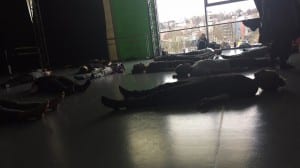Week One: 27/01
The first lesson was an introduction to Improvisation which meant that we were able to discover the types of movement we’d be exploring and the concepts. The first exercise we did in class enabled me to have a feel for my body and meant I could find my breath and notice any tight muscles in my body or any areas discomfort, “A divine sensation, as breath flows into my bones, the ribs rise up and the diaphragm stretches to accommodate the newly filled lungs, a tiny swell through the torso” (Midgelow, 2012). As I was able to breath into my body, I felt like I was able to identify the areas that I could move into and adapt the movements such as pushing, pulling, twisting and folding into what I felt was the most beneficial for my body and to ease some of the pain and stiffness I felt. This movement process also surprised me as I was recognising movement that felt comfortable in my body and repeating it, but the action was from a constantly-changing starting point so it was never the same. I thought this was really interesting as the action was changed each time and I was discovering different things about the movements and about my body. “I have an excess of memory. Memories of past actions” (Midgelow, 2012) I also realised that habitual movements play a huge part in the ‘improvisation’ I have already done and that there are lots of habits that I need to break in order for me to be able to improvise properly.
The second exercise I was with my partner Emily and we had to react from the different body parts that were touched by our partner. This was also a very surprising method of improvisation for me as I had never imagined that there was so much thought process into movement reaction of that speed. There were challenges with this exercise as it was difficult to think of different movements when the partner touched the same body part as some actions became natural and it was hard to break away from those habits. Similarly, it was difficult to touch different body parts on my partner to spark spontaneity as I was able to look at the movements of my partner and absorb them for when I was going to be experimenting with this method. I found it endearing that this movement had some form of a free flowing element to them and my improvisation was able to move around the space but I had no pathway in mind and I hadn’t thought about travelling my movements “I’m not sure where I’m going. I have no destination.” (Midgelow, 2012). This wasn’t what I expected to happen with this method as I presumed the movements would be more gestural and would be quite static but they moved around the space and I was able to create pathways with my partner that we not pre-considered.
Bibliography
Midgelow, V. L., 2012. Dear Practice … : The experience of improvising. s.l.:Intellect.
